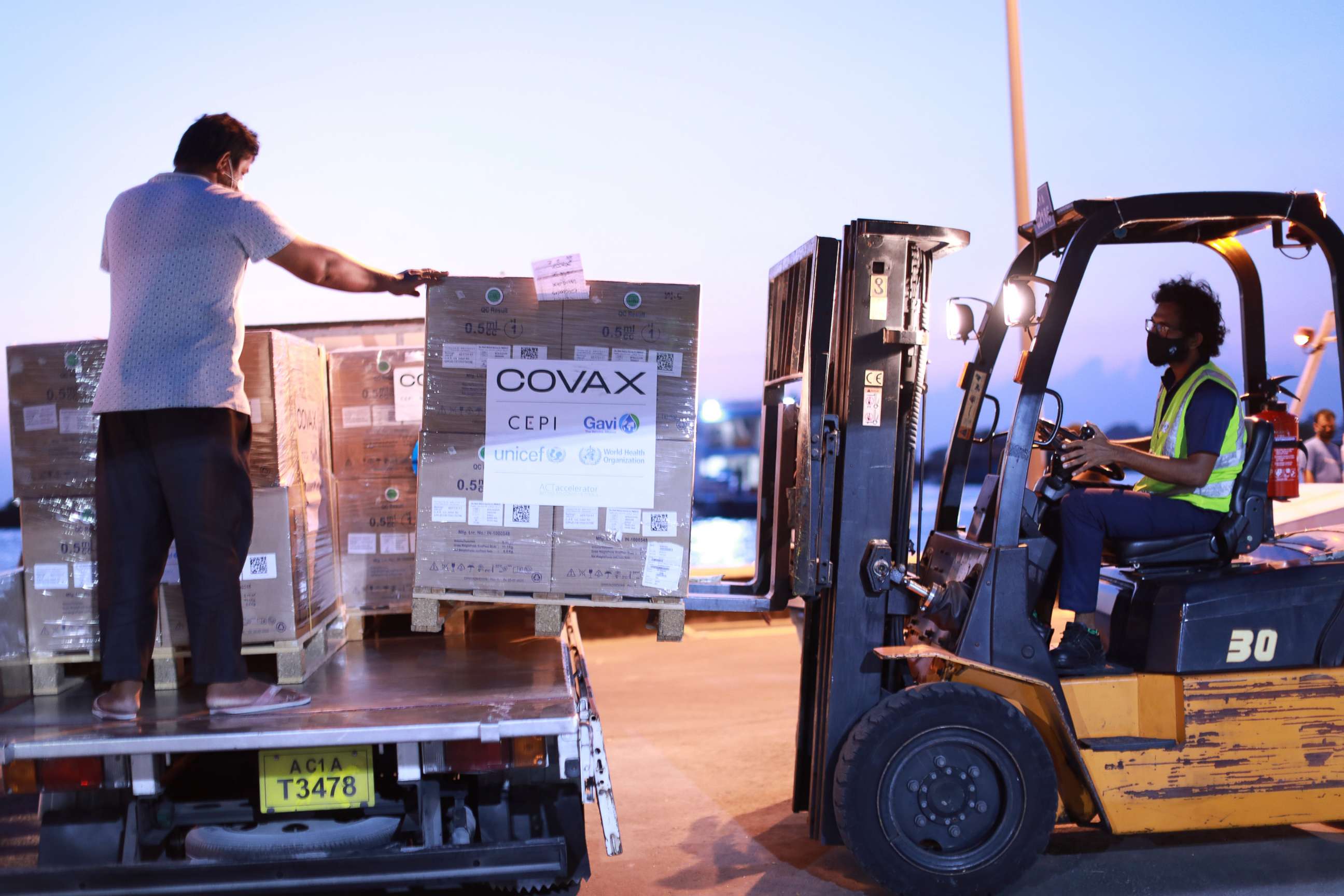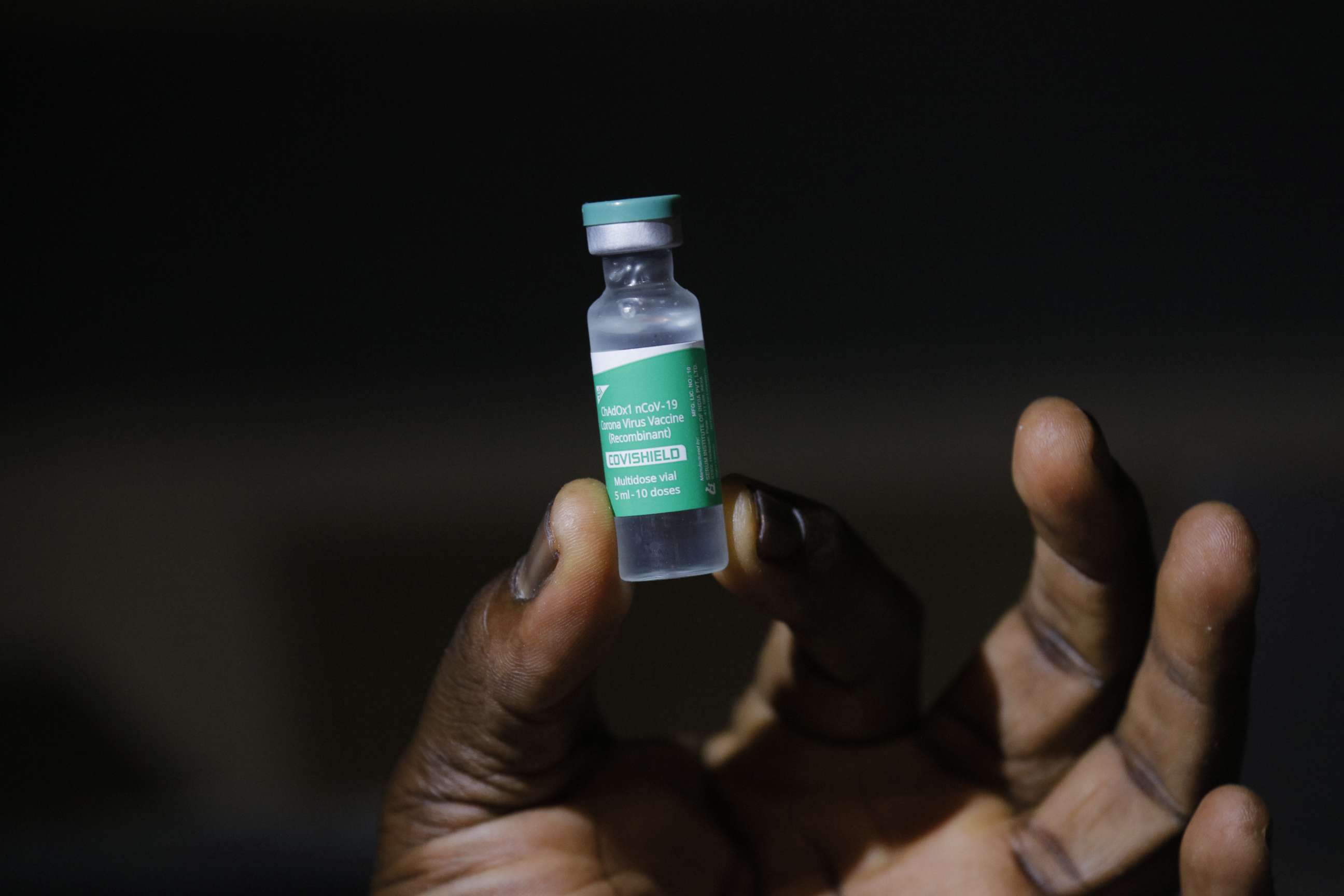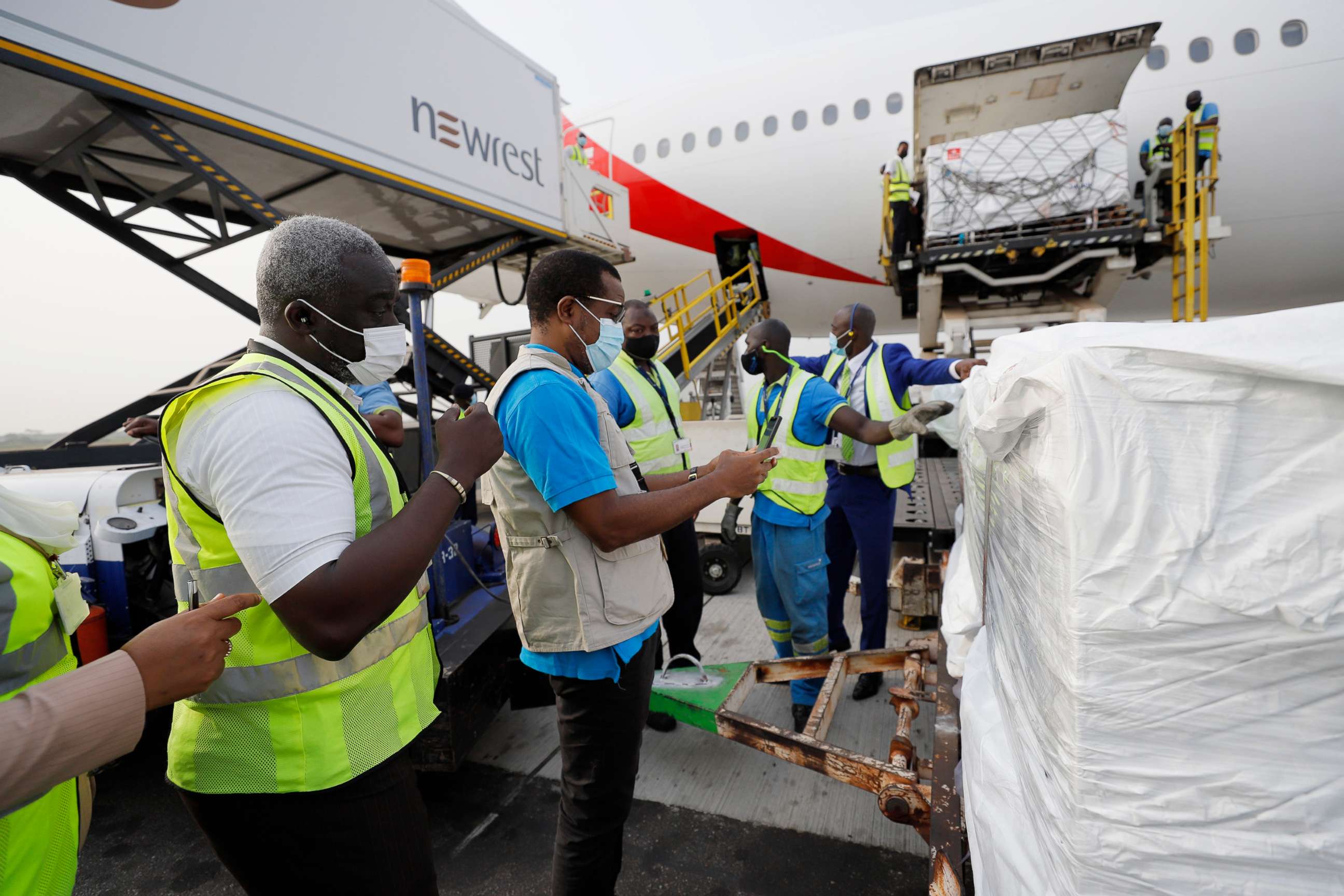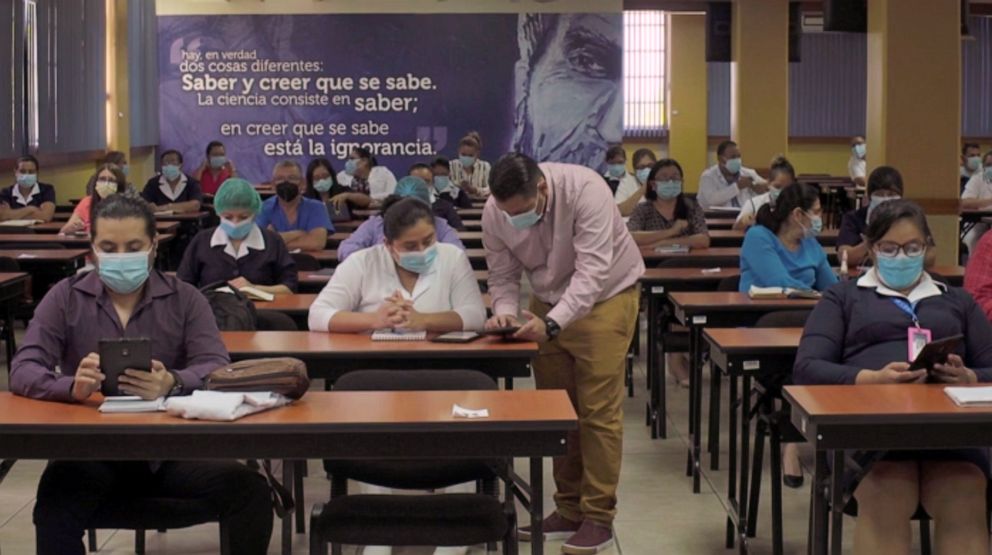What is COVAX? How a global initiative is helping get COVID-19 vaccines to poorer countries
COVAX may be the best bet on worldwide immunization against COVID-19.
LONDON -- As rich countries race to inoculate their populations against COVID-19, poorer nations have fallen behind in the biggest vaccination campaign in history.
But a global vaccine-sharing scheme aims to ensure rapid and equitable access to vaccines for all countries regardless of income. Although there are a number of obstacles, the COVID-19 Vaccine Global Access (COVAX) initiative may be the best bet on worldwide immunization against the novel coronavirus.

What is COVAX?
COVAX is part of the Access to COVID-19 Tools (ACT) Accelerator, a framework for global collaboration that was set up in response to a call from G20 leaders in March 2020 at the start of the coronavirus pandemic and was subsequently launched by the World Health Organization (WHO), the European Commission, France and the Bill & Melinda Gates Foundation in April 2020. The ACT Accelerator is made up of three pillars: Diagnostics, therapeutics and vaccines, according to the WHO.
COVAX is the vaccines' pillar and is co-managed by three partner agencies: Gavi, The Vaccine Alliance (Gavi), the Coalition for Epidemic Preparedness Innovations (CEPI) and the WHO. It is the only global initiative that is working with governments and manufacturers to ensure COVID-19 vaccines are available worldwide to both higher-income and lower-income countries.
"The pandemic has highlighted more than ever the nexus between equity and global health security," Anuradha Gupta, deputy CEO of Gavi, said in a video statement on Feb. 23. "It has also highlighted the vital importance of global solidarity that is epitomized by COVAX."
COVAX acts as a platform that will support the research, development and manufacturing of a wide range of COVID-19 vaccine candidates and will negotiate the pricing. By joining COVAX, all participating countries and economies -- regardless of their ability to pay -- will have access to a portfolio of COVID-19 vaccines, once they are developed and proven to be both safe and effective, according to GAVI.
The portfolio of vaccine candidates -- the largest in the world -- is managed by CEPI's research and development experts.
"The best chance of success is to hedge risk by creating a diverse portfolio of vaccine candidates, based on a range of vaccine technologies," CEPI says on its website. "The breadth of our portfolio will increase our chances of developing multiple successful vaccines, which is crucial if we are to meet global demand and protect vulnerable populations."

What is the goal?
The initial goal is to procure and fairly distribute 2 billion doses of COVID-19 vaccines across almost 200 countries and economies by the end of 2021 through a mechanism, the COVAX Facility, created by Gavi. That should be enough to protect high-risk and vulnerable people as well as front-line health care workers, according to Gavi.
Most importantly, COVAX also aims to ensure that 92 middle- and lower-income countries that cannot fully afford to pay for COVID-19 vaccines themselves get equal access to them, just as higher-income, self-financing countries do and at the same time.
Vaccine research and development is critical to achieving this goal, with an estimated $2.1 billion needed to move three COVID-19 vaccine candidates to licensure, according to CEPI. COVAX has already made bilateral agreements with various vaccine makers, including U.S. pharmaceutical giant Pfizer.
In late December, the WHO issued an emergency use listing for a COVID-19 vaccine developed by Pfizer and its German partner BioNTech. In mid-February, the WHO issued emergency use listings for two versions of a COVID-19 vaccine developed by England's University of Oxford and British-Swedish pharmaceutical giant AstraZeneca -- one made in India and the other in South Korea. The WHO is on track to approve other vaccine candidates for emergency use in the coming months.
According to an interim distribution forecast published in early February, COVAX plans to distribute an initial batch of 336 million doses of the Oxford/AstraZeneca vaccine by mid-2021. It also aims to start shipping 1.2 million doses of the Pfizer/BioNTech vaccine in the first quarter of the year.
"We're on track to meet our targets. We have countries signed up; we have doses secured; and we have raised billions of dollars in funding," Aurelia Nguyen, managing director of the COVAX Facility, said in a video statement on Feb. 24. "Nothing like this has ever been attempted before, and so every day has brought new challenges – both seen and unforeseen – but we are now delivering on our promise to people across the world, and vaccines are on their way."

How does it work?
Countries and economies of all income levels can participate in the COVAX Facility, either in a self-financing capacity or through a separate financing instrument called the Gavi COVAX Advance Market Commitment (AMC). The AMC is funded mainly through government aid, as well as contributions from the private sector and philanthropy, and it supports access to COVID-19 vaccines for 92 middle- and lower-income countries, according to Gavi.
Self-financing participants will be guaranteed sufficient doses of COVID-19 vaccines to protect a certain proportion of their population, depending how much they buy into the scheme. Additionally, richer countries and economies will pay a premium to subsidize poorer ones.
Meanwhile, funded participants will receive enough COVID-19 vaccine doses to inoculate up to 20% of their population in the longer term, subject to funding availability.
Since the United States officially rejoined the WHO, President Joe Biden has pledged $4 billion in contributions to COVAX.
Allocation of vaccine doses will be spread across participants based on the amount that's available. These allotments will grow as availability increases, according to Gavi.
The COVAX Facility has access to vaccine doses through deals that Gavi strikes with vaccine manufacturers on behalf of the program. Meanwhile, the United Nations International Children's Emergency Fund (UNICEF) is leading the vaccine procurement and delivery efforts on behalf of COVAX.
UNICEF has already begun delivering initial shipments of COVID-19 vaccine doses. This week, the West African nations of Ghana and Cote d'Ivoire became the first and second recipients, respectively, to receive doses from the COVAX Facility -- a historic step in the global endeavor.
"It's about a million doses total to begin with and that will just begin accelerating now," Michael Nyenhuis, president and CEO of UNICEF USA, told ABC News in a recent interview. "We've done all of the pre-work necessary in many, many of these countries to make sure that the supply chains are ready, that the health systems are ready, that the refrigeration is ready where it's needed for the vaccines, that the vaccinators, the people actually administer the vaccine in communities, are ready."

Why do we need it?
The global pandemic has already claimed the lives of millions of people and has disrupted the lives of billions more. In addition to reducing further loss of life and helping to get the virus under control, the WHO estimates that the introduction of a vaccine will prevent the loss of $375 billion to the global economy every month.
Global equitable access to a vaccine is the only way to mitigate the public health and economic impact of the pandemic, according to the WHO.
"Developing a vaccine against COVID-19 is the most pressing challenge of our time -- and nobody wins the race until everyone wins," the WHO says on its website.
Without a global initiative like COVAX, there is a very real risk that the majority of people in the world will go unprotected against COVID-19, allowing the virus and its impact to continue unabated, according to Gavi.
"With a disease that spreads as fast as COVID-19, vaccines will only be effective if everyone is protected," Gavi CEO Seth Berkley said in a video statement on Feb. 24.
COVAX was created to maximize the chances of successfully developing COVID-19 vaccines and to produce them in the quantities needed to end the pandemic, all while ensuring that income level does not become a barrier to accessing them.
"It's an all-hands-on-deck effort to do something that's never been done before, the largest global vaccine campaign ever and the largest single thing that UNICEF has ever done," Nyenhuis said. "This is nothing less than a historic effort to end the global pandemic. The only way that we're going to end this is if enough people are vaccinated all around the world to put a stop to it."

What are the challenges?
A global effort to vaccinate the world's population won't be without its challenges.
"There are three things that really need to come together well in order for this to happen," Nyenhuis noted. "One is the production of the vaccine."
COVID-19 vaccines need to continue being developed and manufactured and production needs to ramp up. Vaccine makers also must monitor new variants of the virus to see if any changes need to be made to their vaccines, Nyenhuis said.
"The second piece is supply chain and logistics," he continued. "How do you get all those vaccines from manufacturing out to everybody who needs them? We've seen here in the U.S. what a challenge that has been and it's an even greater challenge when you're talking about countries with less sophisticated infrastructure."
UNICEF, however, has an advantage in this part of the puzzle. The agency is the main procurement partner of Gavi and is the largest single vaccine buyer in the world, procuring more than 2 billion doses of life-saving vaccines every year for routine immunization and outbreak response on behalf of nearly 100 countries. UNICEF will use the same supply chains and expertise to coordinate the procurement and supply of COVID-19 vaccines for the COVAX Facility, according to Nyenhuis.
"The third piece is vaccine confidence or, to put the other way, hesitancy," he said. "How do you combat hesitancy at the community level for people? How do you build confidence so that people actually take the vaccine?"
In the past, vaccine hesitancy has been a challenge in some parts of the world when trying to stamp out other virus outbreaks. Trust and confidence in vaccines need to be built at the community level so that people will actually choose to get inoculated when doses become available, Nyenhuis said.
"So you really need all three of these pieces. You need the production side, you need the supply chain side and you need the community-level confidence," he added. "And there are challenges in all three pieces of that. That's why this is such a Herculean task and such an important effort."




